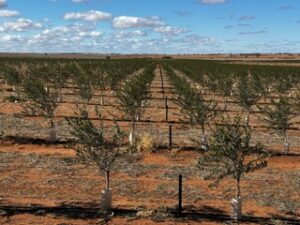Margins are tight, operating costs are rising, and market oversupply isn’t going anywhere fast. If you’ve got a block that’s costing more than it’s making, it’s time to start asking: what else could this land be doing?
Super High-Density (SHD) Olive Oil Production is a smart, low-labour alternative that makes full use of your existing equipment and skills. More importantly, it starts paying you back in just three years.
This isn’t a backup plan. It’s a strategic move backed by proven systems, growing demand, and strong fit-for-region outcomes — especially in areas like McLaren Vale.
Australia produces just 30% of the olive oil it consumes. The rest is imported, despite strong consumer preference for fresh, local, high-quality product.
McLaren Vale and similar wine regions are ideally suited to olive production. The Mediterranean climate, established irrigation networks, and existing trellising and harvesting equipment make the transition simple — and importantly, most growers already have the core skills needed to cultivate a successful, profitable crop. You’re not starting from scratch; you’re building on what you already know.
Unlike traditional olive groves, SHD systems are designed for efficiency from the ground up. Trees are planted in tight rows, machine-shaped, and harvested mechanically. Growers reduce labour requirements and begin production as early as Year 3.
If your vineyard rows are 3.0 metres or wider, the news is good — you can likely keep much of the existing trellis. Remove the vines, reduce wires and posts, rip between rows, and upgrade your driplines if needed.
However, for tighter blocks, full removal and reinstallation at 3.6–3.75 metre spacing is required to ensure access for harvesters and long-term viability.

Trees aged 11 months — Renmark, SA.
Photo courtesy of Tom Culgoa & Sam Freeman (DJ’s).
This is the big investment year — site preparation, trellis adjustments, irrigation, tree planting, and nutrition. Depending on whether you’re starting from scratch or converting vineyard infrastructure, costs range from $35,000–45,000 per hectare. This phase sets the groundwork, but it’s not just about logistics — it’s where olive-specific decisions begin.
Recent advancements in cultural varieties — through genetic selection and hybridising — mean today’s SHD olive trees are more productive, more compact, and better suited to mechanical maintenance.
Irrigation and nutrition are critical during this year, and timing is everything. From the outset, machine shaping replaces traditional vine-style hand training, saving significant labour and establishing uniform growth early.
SHD olives are planted at 1.3–1.5 metre spacing, shaped by machine, and managed with systems grape growers already understand.
This is the year of structure — trees put on their main growth, and regular machine hedging maintains shape and density. Apart from initial hand trimming and occasional sucker removal, machines handle training; significantly reducing labour needs. Growers manage trees using familiar vineyard machinery, making this a win for equipment utilisation. Costs sit around $3,800 per hectare, with most of the heavy lifting already behind you. No hand training. No endless hours tying down canes.
This isn’t reinventing the wheel — it’s using your vineyard know-how in a more efficient format.
SHD systems are designed to reach cropping phase quickly — and you harvest using the same grape harvester you already own.
There’s no handpicking, no extra harvest crews, and no surprises. From here on, annual costs sit around $4,500 per hectare, significantly lower than traditional viticulture.
| Stage | SHD Olives (Est.) | New Vineyard (Est.) |
|---|---|---|
| Year 1 – Establishment | $35K-45K/Ha | $65K-90K/Ha |
| Year 2 – Growth | ~$3.8K/Ha | ~$7.5K/Ha |
| Year 3 – Harvest | ~$4.5K/Ha | No ROI yet |
This isn’t a trend. It’s a system that makes sense:
Ultimately, SHD olives aren’t just a response to dropping grape prices — they’re a long-term opportunity for mixed horticulture, income stability, and future-proofing your business.
At Pridham Viticulture, we’re not just contractors. We’re growers, planners, and a family business that understands how hard it is to make the right call when the numbers stop adding up.
We’re walking the same road you are. If you’re thinking about removing vines or reassessing a block’s potential, we’re here to help you crunch the numbers and support you through the process.
Get in touch with our team. Let’s talk olives. Let’s talk what’s next.